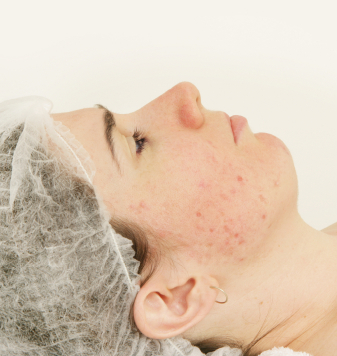Acne Scars – Causes, Symptoms, Treatments
|
Reading time: 7 minutes
|

Key Takeaways
- Acne scars are marks left on the skin after acne heals and affect nearly half of those who have had acne.
- Types of scars include atrophic scars, which are depressions in the skin, and hypertrophic and keloid scars, which are raised.
- Scars form due to inflammation and damage to the skin’s deeper layers from severe acne or tampering with pimples.
- Factors like untreated acne, genetics, and skin type can affect scar formation, with severe inflammatory acne posing the highest risk.
- Acne scars can have lasting effects on self-esteem and mental health, but treatments like topical medications, minimally invasive procedures, laser therapy, and surgical techniques can help improve their appearance.
What are Acne Scars?
Acne scars are imperfections left on the skin after acne blemishes have healed. While not everyone who gets acne will develop scars, they are a common occurrence, affecting a significant portion of the global population.
While exact figures can vary slightly depending on the study, research suggests that around 47% of people with acne will develop acne scars.
Types of Acne Scars
Atrophic scars are the most common type of acne scar. They appear as depressions in the skin and can be further categorized into three types based on their unique characteristics:
- Ice pick scars are narrow and deep, with pointed edges that resemble the tip of an ice pick. They typically form after severe inflammatory acne and tend to appear on the cheeks.
- Rolling scars have a rolling appearance, creating an uneven texture on the skin’s surface. They are often more noticeable on the cheeks and temples.
- Box scars have sharp, well-defined edges and a deep, U-shaped appearance. They can develop anywhere on the face, but are most common on the jawline and lower cheeks.
Hypertrophic scars and keloid scars are raised scars that form due to an overproduction of collagen during the healing process. They are less common than atrophic scars and are more likely to occur on the chest, back, and shoulders than on the face.
Hypertrophic scars are typically confined to the area of the original blemish and do not extend beyond the edges. On the other hand, keloid scars grow larger than the original blemish and can continue to grow over time.
How do Acne Scars Form?
Acne scars develop due to the body’s healing response to inflamed acne blemishes. Several factors can influence whether or not scars form.
Mild acne with whiteheads and blackheads typically doesn’t cause scarring. However, severe inflammatory acne, particularly those with deep lesions like cysts and nodules, are more likely to damage the skin’s deeper layers and lead to scar formation.
Tampering with acne lesions can worsen inflammation and increase the risk of scarring. Picking or squeezing introduces bacteria deeper into the skin and disrupts the natural healing process, potentially leading to uneven collagen production and scarring.
Some people are also genetically predisposed to develop scars more easily than others. This means their skin may overproduce or underproduce collagen during healing, impacting the final outcome.
Here’s how severe acne lesions like cysts, nodules, and papules can lead to scarring:
- Deep Tissue Damage: These inflammatory lesions penetrate deep into the skin’s dermis, the layer containing collagen and elastin fibers responsible for skin structure and elasticity. The deep inflammation and breakdown of tissue can significantly disrupt the collagen production process.
- Excessive Collagen Production: In some cases, the body goes into overdrive trying to repair the damage from deep acne lesions. This can lead to an overproduction of collagen, resulting in raised hypertrophic or keloid scars.
- Insufficient Collagen Production: Alternatively, the healing process might not produce enough collagen, leading to a loss of tissue and the formation of atrophic scars like ice pick, rolling, or box scars.
Factors Affecting Acne Scarring
As previously stated, the severity of acne is the biggest contributing factor. Severe inflammatory acne, particularly with deep lesions like cysts and nodules, damages the skin’s deeper layers and disrupts collagen production, leading to a higher risk of scarring. Even moderate acne can leave scars, though it’s less common.
Additional factors include:
- Untreated Acne: When acne goes untreated, inflammation persists, increasing the chance of tissue breakdown and subsequent scarring during healing. Consistent treatment with acne medication helps reduce inflammation and minimize scar formation.
- Age: Although acne is most prevalent in teenagers and young adults, acne scars can develop at any age. Studies haven’t shown a definitive link between age and scar formation risk.
- Gender: Research suggests some variations between genders. While both men and women experience acne scars, some studies indicate a slightly higher prevalence in women. This might be due to hormonal factors or differences in how persons handle acne lesions (picking or squeezing).
- Skin Type: People with darker skin tones (Fitzpatrick skin types IV-VI) are more prone to a type of scarring called post-inflammatory hyperpigmentation (PIH) after acne heals. PIH appears as dark spots but isn’t a true scar and can often fade over time with proper skincare. However, these individuals may also be more susceptible to developing true acne scars due to factors like increased inflammatory response and altered collagen production.
Potential Complications of Acne Scarring
The long-term consequences of acne scars can be multifaceted, affecting a person both physically and emotionally.
Unlike post-inflammatory hyperpigmentation (PIH) that fades over time, acne scars are permanent. While some treatments can improve their appearance, they won’t completely disappear.
Acne scars can lead to a negative body image and a decline in self-confidence. The constant focus on flaws can cause feelings of being unattractive or even ugly. Fears of judgment or negative social interactions due to scars can trigger social anxiety and withdrawal. People might avoid social events or activities that involve exposing their skin, limiting their overall enjoyment of life.
In severe cases, acne scars can contribute to depression, particularly when coupled with social isolation and low self-esteem. For some individuals, acne scars might become a fixation, leading to BDD, a mental health condition where a person obsesses over a perceived flaw in their appearance. This can cause significant distress and require professional treatment.
Available Treatment Options for Acne Scars
Acne scars come in various forms, and the best course of treatment depends on the specific type, depth, and severity of the scars. Here’s an overview of different options a dermatologist might recommend to improve their appearance:
Topical Treatments:
- Retinoids: These over-the-counter or prescription creams stimulate collagen production and cell turnover, potentially helping to improve the appearance of mild atrophic scars.
- Alpha Hydroxy Acids (AHAs): These gently exfoliate the top layer of skin, promoting smoother texture and potentially minimizing the visibility of shallow scars.
Minimally Invasive Procedures:
- Microneedling: This treatment uses a roller with tiny needles to create controlled punctures in the skin. The micro-injuries trigger the body’s healing response, stimulating collagen production and potentially improving the appearance of atrophic scars.
- Dermabrasion: A controlled sanding technique removes the topmost layers of skin, aiming to even out the skin texture and potentially reduce the visibility of shallow scars. However, dermabrasion is less commonly used today due to the risk of side effects and the availability of safer alternatives.
- Chemical Peels: Similar to dermabrasion, chemical peels use controlled application of acidic solutions to remove outer skin layers. The depth of the peel can be adjusted to target superficial or deeper scars.
Laser Therapy:
- Ablative Lasers: These lasers precisely remove damaged skin layers, promoting collagen production and potentially improving the appearance of various scar types, including deeper atrophic and raised scars. However, ablative lasers involve more downtime and recovery compared to non-ablative options.
- Non-Ablative Lasers: These lasers deliver heat energy below the skin’s surface, stimulating collagen production without removing tissue. They are often used for milder scars or as a complementary treatment with other options.
Surgical Techniques:
- Punch Excision: For isolated, deep scars, a dermatologist might use punch excision to remove the scar tissue and then stitch the surrounding skin together.
- Subcision: This minimally invasive technique uses a needle to break down fibrous tissue tethering under atrophic scars, potentially lifting them and creating a smoother appearance.
- Scar Revision: In some cases, surgical techniques like scar revision can be used to reshape or camouflage existing scars, aiming for a more aesthetically pleasing outcome.
What Medications Are Most Prescribed to Treat Acne Scars?
It’s important to understand that there are no medications specifically prescribed to treat acne scars. Medications are primarily used to treat active acne breakouts, which can help prevent future scarring. However, some medications commonly prescribed by dermatologists can indirectly improve the appearance of existing acne scars:
- Topical retinoids: These come in over-the-counter and prescription strengths. They work by increasing cell turnover and stimulating collagen production, which can potentially improve the appearance of mild atrophic scars (depressed scars). Examples include tretinoin, adapalene, and tazarotene.
- Topical antibiotics: While not directly targeting scars, these medications can be helpful if you still have occasional breakouts. By controlling inflammation and reducing bacterial growth, they can minimize the risk of further scarring from new acne lesions.
Information provided on this website is for general purposes only. It is not intended to take the place of advice from your practitioner







